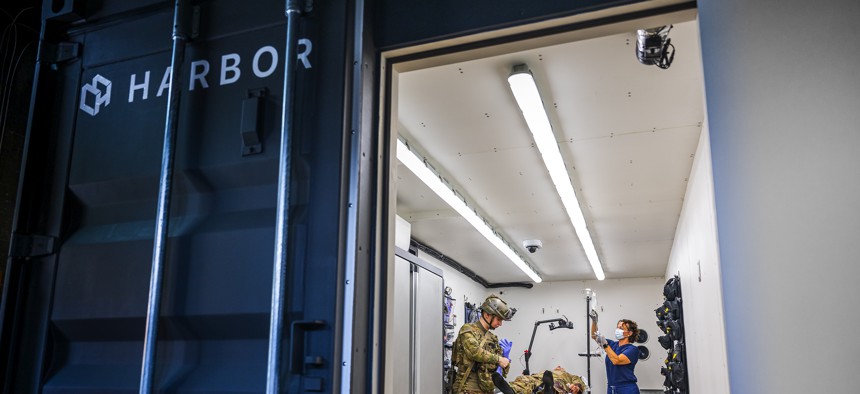
A startup called Valinor has just unveiled what is essentially a field hospital in a box—one with integrated software and data connectivity missing from today’s battlefield medicine.
The Harbor is a 20-foot shipping container that can be modified for different types of battlefield care, such as immediate damage control or prolonged casualty care. The exterior can be hardened against ballistics and it can be modified to power anti-drone defensive systems. Anduril is partnering with Valinor to allow telehealth over Anduril’s Lattice mesh network, in order to better manage the electro-magnetic signatures coming to and from the unit, to make it more difficult to target by enemy drones, etc.
Luke Sciuli, head of medical innovation at Valinor, spoke with Defense One about the idea. He’s a former Army medic who has made more than 10 visits to Ukraine since the start of Russia’s 2022 expanded invasion, embedding with different humanitarian organizations there. “These trips have provided visceral proof of just how quickly the nature of warfare is changing, even versus my time in Special Forces less than a decade ago,” he told Defense One over email.
One key change he’s seen emerge from the war zone in Eastern Europe: the deliberate targeting of frontline medical workers is increasingly common practice. The fight also shows that drone warfare makes air superiority elusive, which complicates getting helicopters into combat zones to pull the wounded from the field. Evacuations that should take minutes in Ukraine now take between 72 and 96 hours, he said. That’s key, the United States relied heavily on medical evacuations to reduce battlefield casualties in its Middle East operations. Those two factors create a need for much more advanced battlefield medical care, because medical evacutions will be much more difficult and the need for frontline care would be much higher.
While it’s tempting to think the better-resourced U.S. military wouldn’t face the same challenges, high-intensity warfare is likely to produce far more casualties—and far more quickly—than the engagements the U.S. has fought so far this century.
Today, the U.S. can set up an Army field hospital in about 72 hours, according to 2018 studies but they are expensive to run—upwards of $3 million a month, according to a separate 2015 study based U.S. field-hospital deployments in Afghanistan, the most recent academic data available. And field hospitals don’t compare to regular hospitals in terms of modern health monitoring or other capabilities.
This year, the company developed and delivered prototypes to the Marine Corps and special operations forces. The units can be modified depending on the deployment context. “Looking forward, we have secured the team and resources to produce [approximately] 300 units in 2026, if contracted to do so. We designed Harbor from first principles to support mass manufacturing, including edge manufacturing or production overseas,” he said.
Harbor can be set up in minutes and units start around $300,000, which puts them “several orders of magnitude less [in cost] than other traditional medical solutions,” he said. Each unit includes a hardened exterior for force protection, providing more protection than a tent.
But the most important upgrade is the integration of modern information technology into battlefield medicine—sensors, connectivity, and other features–that have been shown to improve medical outcomes in emergency triage situations. In essence, each unit is both a sickbay but also a computer platform with an operating system capable of running apps.
Sciuli told Defense One: “A big emphasis for us in building Harbor [operating system] was the ability to do a lot of treatment remotely, including embedded telehealth, remote monitoring of various vitals, offline clinical resources—think video-assisted guides for different procedures and emergency medicine—and even remote control of certain devices, including ventilators, IV fluid pumps, and IV syringe pumps. It’s both about making it easier for clinicians and medics on the ground to do more with less, and for remote caregivers to be more connected and able to help actively on the front lines.”
The post Startup aims to reinvent battlefield medicine for the drone era appeared first on Defense One.




